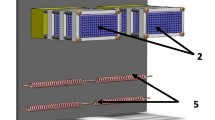Abstract
We present the results obtained from the development and tests of a reagentless method to prevent biofouling in water cooling systems of equipment using generators of OH radicals and ozone constructed on the basis of impulse ultraviolet xenon lamps producing light with a wavelength of 172 nm.
Similar content being viewed by others
References
A. A. Gerasimenko, Protection of Machines, Equipment, and Structures from Corrosion, Ageing, and Biological Damage. A Handbook (Mashinostroenie, Moscow, 1987) [in Russian].
V. I. Terent’ev, S. V. Karavan, and N. M. Pavlovets, Control of Corrosion in Water Supply Systems (Prospect Nauki, St. Petersburg, 2007) [in Russian].
K. Holmberg, B. Yensson, B. Cronberg, and B. Lindman, Surfactants and Polymer in Aqueous Solutions (BINOM. Lab. Znanii, Moscow, 2009) [in Russian].
E. L. Gogolashvili, Yu. Koppe, and I. Tielemann, “The MOL-CLEAN Technology: An Advanced Method to Control Biofouling,” Energetika Tatarstana, No. 2 (10), 45–50 (2008).
Author information
Authors and Affiliations
Additional information
Original Russian Text © S.V. Izyumov, E.Yu. Shchekotov, D.E. Shchekotov, D.A. Krutskikh, 2011, published in Teploenergetika.
Rights and permissions
About this article
Cite this article
Izyumov, S.V., Shchekotov, E.Y., Shchekotov, D.E. et al. A reagentless technology to prevent biofouling on the surfaces of equipment at nuclear and thermal power stations using generators of OH radicals and ozone. Therm. Eng. 58, 566–571 (2011). https://doi.org/10.1134/S0040601511070068
Published:
Issue Date:
DOI: https://doi.org/10.1134/S0040601511070068




